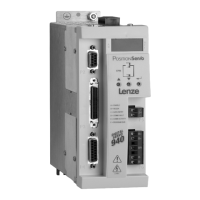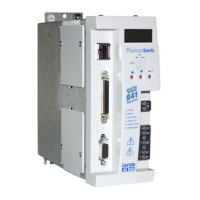S94H201E_13426446_EN L 85
Operation
Further Increased Position P-Gain
Shows very good reduction to the maximum
error but with additional oscillations starting
to occur.
Step 2: Setting the Position D-Gain
Slowly increase the D-Gain while watching the position error waveform on oscilloscope Channel 1. As the
D-Gain is increased, the position error oscillation caused by the P-Gain, should start to decrease. Continue
to increase the D-Gain until oscillation is gone or until D-Gain is no longer having any apparent effect.
Adjustment of Position D-Gain
in conjunction with the P-Gain dampens
out additional oscillations while improving
position error.
For optimum tuning, it is sometimes required to repeat the process of increasing the P-Gain until a slight
oscillation occurs and then increase the D-Gain to suppress that oscillation. This procedure can be repeated
until the increasing of D-Gain has negligible effect on the position error waveform.
Step 3: Setting the Position I-Gain and Position I-Gain Limit
The objective here is to minimize the position error during steady state operation and improve positioning
accuracy. Start to increase the Position I-gain. Increasing the I-gain will increase the drive’s reaction
time while the I-Limit will set the maximum influence that the I-Gain can have on the Integral loop. When
adjusting the I-gain start with a very small value for the I-gain (e.g. 1) then increase the I-gain parameter
value until stand-still error is compensated and positioning accuracy is satisfactory. Remember that large
values of Position I-limit can cause a large instability in the control loop and unsettled oscillation of the
system mechanics.
Position Error trace following the tuning of
Position P-, I- and D-Gains

